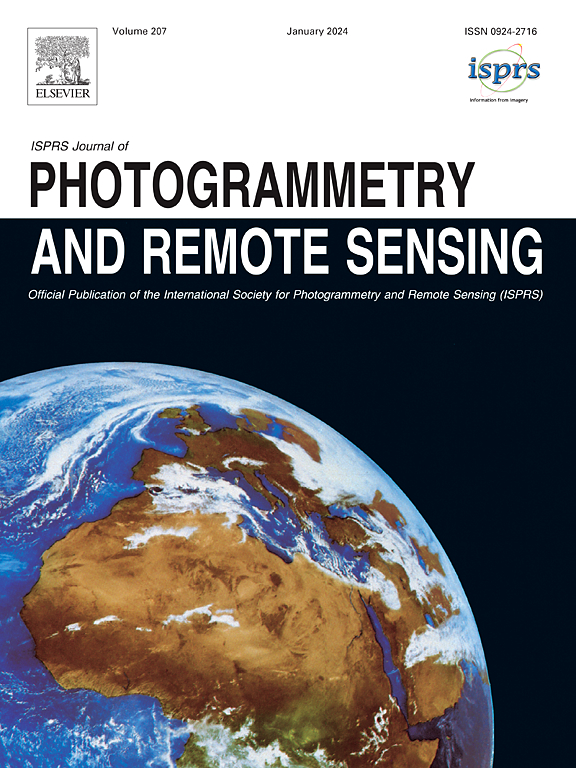Selective weighted least square and piecewise bilinear transformation for accurate satellite DSM generation
IF 10.6
1区 地球科学
Q1 GEOGRAPHY, PHYSICAL
ISPRS Journal of Photogrammetry and Remote Sensing
Pub Date : 2024-11-06
DOI:10.1016/j.isprsjprs.2024.11.001
引用次数: 0
Abstract
One of the main products of multi-view stereo (MVS) high-resolution satellite (HRS) images in photogrammetry and remote sensing is digital surface model (DSM). Producing DSMs from MVS HRS images still faces serious challenges due to various reasons such as complexity of imaging geometry and exterior orientation model in HRS, as well as large dimensions and various geometric and illumination variations. The main motivation for conducting this research is to provide a novel and efficient method that enhances the accuracy and completeness of extracting DSM from HRS images compared to existing recent methods. The proposed method called Sat-DSM, consists of five main stages. Initially, a very dense set of tie-points is extracted from the images using a tile-based matching method, phase congruency-based feature detectors and descriptors, and a local geometric consistency correspondence method. Then, the process of Rational Polynomial Coefficients (RPC) block adjustment is performed to compensate the RPC bias errors. After that, a dense matching process is performed to generate 3D point clouds for each pair of input HRS images using a new geometric transformation called PWB (pricewise bilinear) and an accurate area-based matching method called SWLSM (selective weighted least square matching). The key innovations of this research include the introduction of SWLSM and PWB methods for an accurate dense matching process. The PWB is a novel and simple piecewise geometric transformation model based on superpixel over-segmentation that has been proposed for accurate registration of each pair of HRS images. The SWLSM matching method is based on phase congruency measure and a selection strategy to improve the well-known LSM (least square matching) performance. After dense matching process, the final stage is spatial intersection to generate 3D point clouds, followed by elevation interpolation to produce DSM. To evaluate the Sat-DSM method, 12 sets of MVS-HRS data from IRS-P5, ZY3-1, ZY3-2, and Worldview-3 sensors were selected from areas with different landscapes such as urban, mountainous, and agricultural areas. The results indicate the superiority of the proposed Sat-DSM method over four other methods CATALYST, SGM (Semi-global matching), SS-DSM (structural similarity based DSM extraction), and Sat-MVSF in terms of completeness, RMSE, and MEE. The demo code is available at https://www.researchgate.net/publication/377721674_SatDSM.
选择性加权最小二乘法和片断双线性变换用于精确生成卫星 DSM
在摄影测量和遥感领域,多视角立体(MVS)高分辨率卫星(HRS)图像的主要产品之一是数字表面模型(DSM)。由于多视角立体高分辨率卫星图像的成像几何和外部方位模型复杂、尺寸大、几何和光照变化多样等原因,利用多视角立体高分辨率卫星图像制作数字表面模型仍面临严峻挑战。开展这项研究的主要动机是提供一种新颖高效的方法,与现有的最新方法相比,提高从 HRS 图像中提取 DSM 的准确性和完整性。所提出的方法称为 Sat-DSM,包括五个主要阶段。首先,使用基于瓦片的匹配方法、基于相位一致性的特征检测器和描述符以及局部几何一致性对应方法,从图像中提取非常密集的连接点集。然后,执行有理多项式系数(RPC)块调整过程,以补偿 RPC 偏差误差。然后,使用一种名为 PWB(价格双线性)的新几何变换和一种名为 SWLSM(选择性加权最小平方匹配)的基于区域的精确匹配方法,执行密集匹配过程,为每对输入 HRS 图像生成三维点云。这项研究的主要创新包括引入 SWLSM 和 PWB 方法来实现精确的密集匹配过程。PWB 是一种基于超像素过度分割的新颖而简单的片状几何变换模型,用于准确配准每对 HRS 图像。SWLSM 匹配方法基于相位一致性度量和选择策略,以提高众所周知的 LSM(最小平方匹配)性能。在密集匹配过程之后,最后一个阶段是空间相交,生成三维点云,然后进行高程插值,生成 DSM。为了评估 Sat-DSM 方法,从 IRS-P5、ZY3-1、ZY3-2 和 Worldview-3 传感器上选取了 12 组 MVS-HRS 数据,这些数据来自城市、山区和农业区等不同地貌的地区。结果表明,就完整性、均方根误差和 MEE 而言,拟议的 Sat-DSM 方法优于 CATALYST、SGM(半全局匹配)、SS-DSM(基于结构相似性的 DSM 提取)和 Sat-MVSF 等其他四种方法。演示代码见 https://www.researchgate.net/publication/377721674_SatDSM。
本文章由计算机程序翻译,如有差异,请以英文原文为准。
求助全文
约1分钟内获得全文
求助全文
来源期刊

ISPRS Journal of Photogrammetry and Remote Sensing
工程技术-成像科学与照相技术
CiteScore
21.00
自引率
6.30%
发文量
273
审稿时长
40 days
期刊介绍:
The ISPRS Journal of Photogrammetry and Remote Sensing (P&RS) serves as the official journal of the International Society for Photogrammetry and Remote Sensing (ISPRS). It acts as a platform for scientists and professionals worldwide who are involved in various disciplines that utilize photogrammetry, remote sensing, spatial information systems, computer vision, and related fields. The journal aims to facilitate communication and dissemination of advancements in these disciplines, while also acting as a comprehensive source of reference and archive.
P&RS endeavors to publish high-quality, peer-reviewed research papers that are preferably original and have not been published before. These papers can cover scientific/research, technological development, or application/practical aspects. Additionally, the journal welcomes papers that are based on presentations from ISPRS meetings, as long as they are considered significant contributions to the aforementioned fields.
In particular, P&RS encourages the submission of papers that are of broad scientific interest, showcase innovative applications (especially in emerging fields), have an interdisciplinary focus, discuss topics that have received limited attention in P&RS or related journals, or explore new directions in scientific or professional realms. It is preferred that theoretical papers include practical applications, while papers focusing on systems and applications should include a theoretical background.
 求助内容:
求助内容: 应助结果提醒方式:
应助结果提醒方式:


